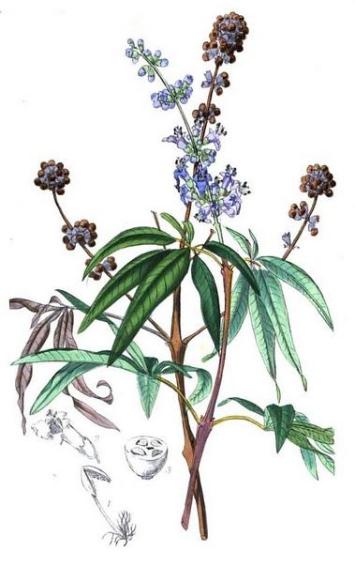“Chaste Tree”

“Vitex will always enable what is appropriate to occur” – David Hoffman
Botanical Name: Vitex agnus-castus
Common name: Chaste Tree, Monk’s pepper
Family: Lamiaceae
Parts Used: Fruit
Active Constituents:
- Flavonoid
- Alkaloids
- Iridoids
- Volatile oil (Blumenthal et al 2000 p63)
Actions:
- Prolactin inhibitor
- Dopaminergic agonist, Progesterogenic
- Galactogogue
- Hypothalamic-pituitary-ovarian (HPO) axis regulator
- Ovulation stimulant / tonic
- Anaphrodisiac (traditionally)
Indications:
- Premenstrual syndrome
- Mastalgia
- Fluid retention
- Progesterone deficiency
- Corpus luteal insufficiency
- Latent hyperprolactinemia
- Cystic hyperplasia of the endometrium
- Secondary amenorrhoea
- Insufficient lactation
- Metrorrhagia (from functional causes), menorrhagia, polymenorrhoea,
- Oligomenorrhoea
- Conditions with raised prolactin secretion (e.g, breast cysts, fibrocystic breast disease, BPH)
- Withdrawal from HRT
- Fibroids
- Endometriosis
- Follicular ovarian cysts
- Infertility resulting from decreased progesterone levels
- Acne
- Galactagogue
- Emmenagogue
- Impotence, sexual melancholia, sexual irritability with nervousness
- Gynaecological problems and insufficient lactation
Contraindications: None Known
Cautions:
- Should be used cautiously during pregnancy and only in the early stages for treating insufficient corpus luteal function
- Chase tree is best not taken in conjunction with progesterone drugs, contraceptive pill, or HRT.
- Chaste Tree may aggravate spasmodic dysmenorrhoea not associated with PMS
May interact antagonistically with dopamine – receptor antagonists
Dosage:
1.0-2.5ml of 1:2 LE per day
6-18ml of 1:2 LE per week
The most common way to take Vitex is 1-2mL in water upon waking in the morning
ARTICLE & MONOGRAPH LINKS:

